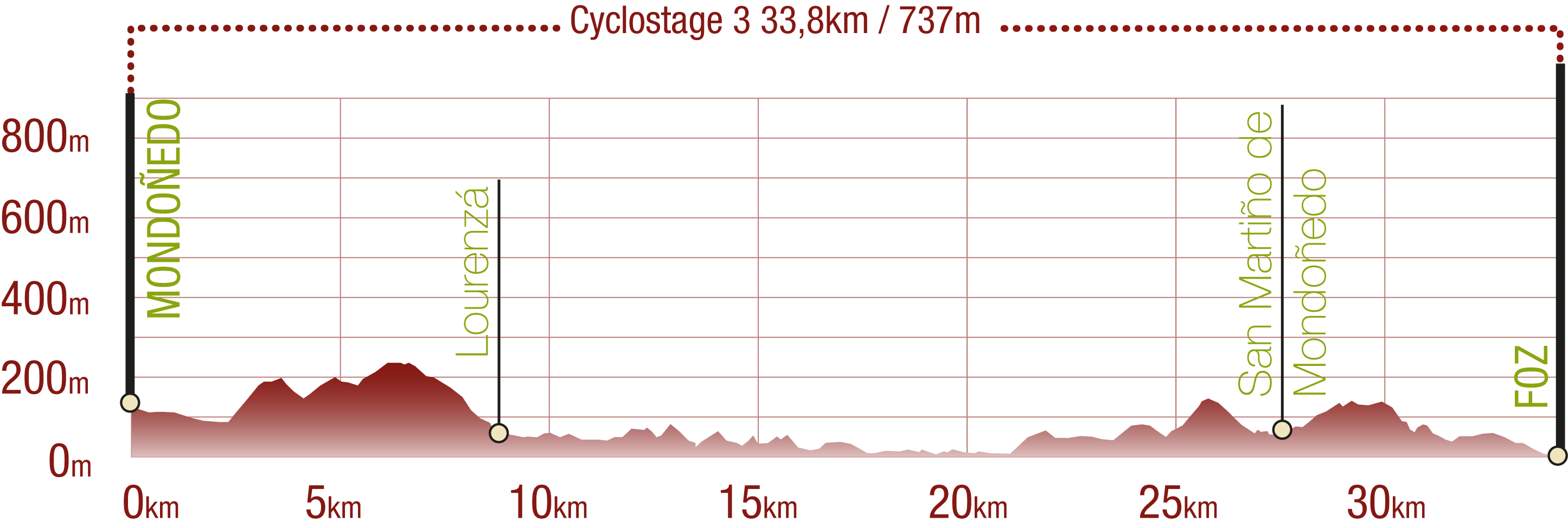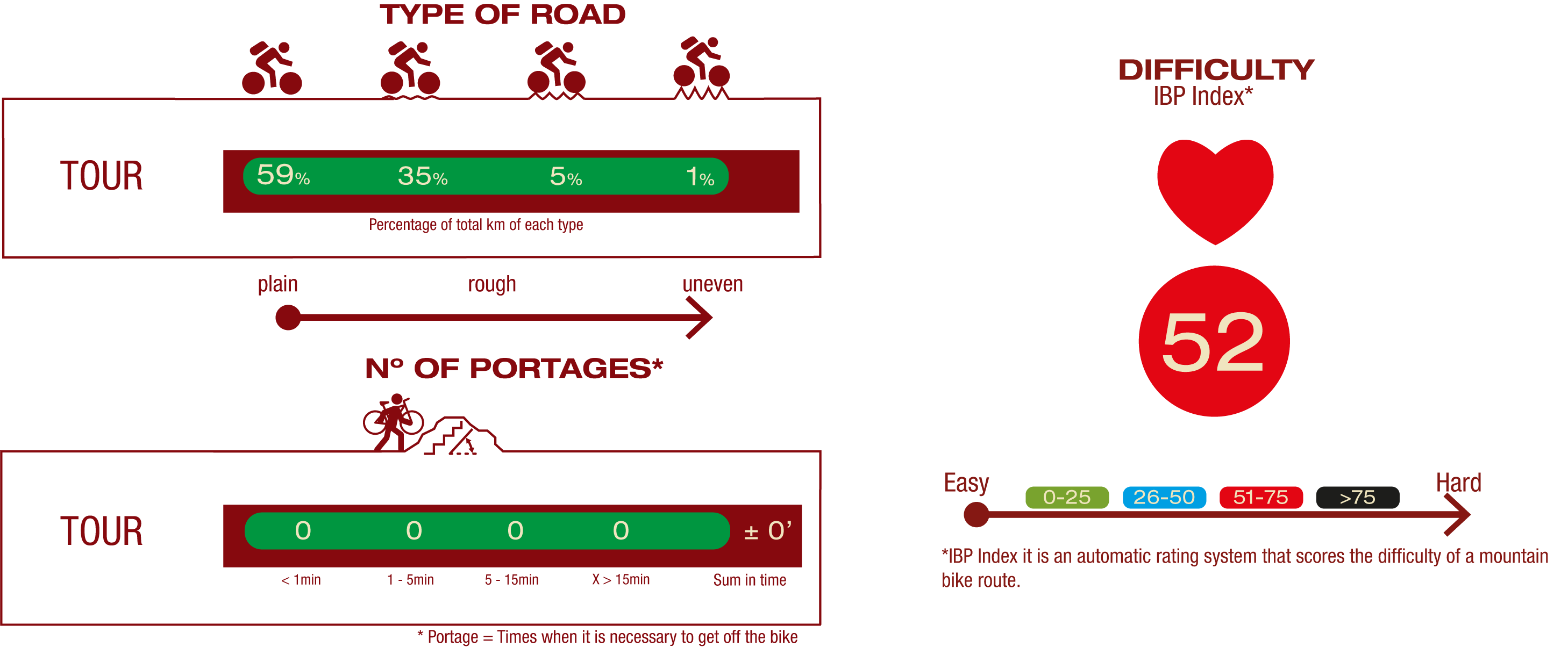Net of Natural
Trails

San Rosendo Nature Trail. Mondoñedo - Foz section
Description
Following the trail of San Rosendo to the Cantabrian Sea
This section of the San Rosendo Nature Trail passes through the towns of Mondoñedo, Lourenzá, Barreiros y Foz, taking the traveller through towns rich with history, hamlets, pastures and stunning mixed forests. A section of this trail coincides with the Camino de Santiago (Way of St. James) and travels along the Masma river until it discharges in the Cantabrian sea and becomes the Foz ria.
This Nature Trail starts in the square in front of the Mondoñedo Cathedral, and takes the street Rúa Pardo de Cela, a narrow street typical of the architecture in Mondoñedo's old town. The Trail leads then to the street Rúa do Camiño Norte, where an information panel about this Nature Trail may be found.
Crossing the LU-124 road, the trail leaves Mondoñedo by the Calle de San Antonio street, the rúa de San Lázaro street and, after crossing the historical San Lázaro bridge, continues by the road to Lorenzana (N-634a). The traveler must be especially careful, since these roads include sections without pavements.
After walking 300 m along the Lorenzana road, the trail turns right in the direction of San Paino by an asphalt road that climbs the hill slope to Reguengo.
Then, it turns lefts, leaving momentarily the asphalt road and the buildings to take a narrow dirt road that leads to San Pedro. After arriving in this neighbourhood, it turns right by the chapel that has lent its name to the nearby hamlet and leaves it by a slab path that, after turning right, becomes a dirt path.
The trail overpasses the back wall of the Mondoñedo graveyard and enters a forest. Soon, the traveler reaches another asphalt road that leads to Grove; however, it must soon be left to take a path to the right which, after passing under a hórreo, an elevated traditional granary typical of Nortwestern Spain, leads to a hamlet next to green pastures. After crossing the N-634a road at the level of the Guadalupe chapel, the traveler continues along the roads that lead to Grove and leaves the place walking between greenhouses.
Until exceeding Arroxo, the trail continues along a dirt path nested between the N-634 road and grazing pastures, and continues under the A-8 Highway, called the Cantabrian Highway. The trail is separated from the road by fences. Once Arroxo has been left behind, the trail again coincides with the Camino de Santiago, and enters a broadleaf forest which continues to the outskirts of Lourenzá, where the forest becomes dotted by meadows.
Leaving the Lourenzá graveyard to our right, the trail leads down to the village though a narrow green path, until reaching the crossroads of the Riego Vilazo and Avelino Montero Villegas streets. The trail takes the latter street but soon turns right to the Plaza de Linares Rivas square, from which a glimpse of the San Salvador Monastery can be taken. The road continues to the left by the travesía de Mariña street until reaching the LU-153 road, where it takes the road to Ferreira, which crosses the Batán creek by a stone bridge. After just 300 metres, the trail crosses the creek again, after turning right at the junction to the town's nature interpretation centre.
The trail leaves Lourenzá by an asphalt road, which passes by a cattle farm and under the A-8 highway before turning right. Afterwards, it continues by a long straight section, leaving at its right the different Lourenzá neighbourhoods and grazing pastures until crossing the LU-P-2804 road.
Approximately 50 m to the right of the crossing, the trail leaves the road and enters a eucalyptus forest, dotted with some oaks. The trail passes again under the A-8 highway, and starts a climb that will last for almost a kilometre. The trail then goes down to a pine forest and takes an asphalt road that leads left, until reaching the bridge over the Masma river in the outskirts of Casolga.
The road is momentarily interrupted but continues 600 m afterwards, in the outskirts of Casolga, by a dirt path that runs in the direction of the Masma river, and which will continue along the river until reaching Celeiro, in the council area of Barreiros. When walking from Celeiros to Mariñaos, the trails passes by a resting area and a fountain, and afterwards, an unused hydroelectric power plant in Pozo Capitan, of which some building are still standing, as well as the remains of the dam that regulated the river flow.
As the trail approaches the town, it becomes an asphalt path again, and the pasture where cattle grazes alternates with patches of woodland, until to the right of the road there is only woords and to the left there are only meadows and farmlands.
After the last crossroads which leads to Celeiro de Mariñaos the trail deviates of the Masma river and leads to Villaronte. It just passes by this village; crossing the outer neighbourhoods and walking past the Capela do Carmen Chapel, just before turning to cross the LU-152 road. At the other side of the road, the trail turns again and starts a long descent straight to Bao.
Before reaching this town, it turns right and turns momentarily towards the mountains, passing behind a group of houses. After 500 m, it turns away from the mountains, crosses over the Centinó river and a road until reaching a road that leads to the Basilica of San Martín de Mondoñedo.
Before leaving San Martín de Mondoñedo behind, continuing by the same toad we arrived, we can have a pretty view of the church and its environment from the nearby graveyard. Afterwards, the trail starts a long climb through a eucalyptus forest until crossing a road, where it is interrupted again. It re-starts after 200 metres, next to the Capilla del Obispo Santo (Chapel of the Bishop Saint).
From the field where this shrine is located, there is an interesting view of Foz, the mouth of the Masma river and the Cantabrian sea.
The road continues its last stretch among eucalyptus and climbs down to the N-642 road, which it reaches by going around Forxán. After passing under the road, the trail turns right by a path that runs parallel to the road, and, after passing over a railway tunnel, it reaches a path that goes into the town of Foz by the Rúa do Calvario Street.
The Nature Trail then continues by the Rúa Lugo street to the Plaza Salgado Toimil Square and afterwards by the Avenida de Valle Inclán avenue, which leads to the commercial area in the Foz port area. Leaving the Fishermen's Guild and the Fish Market to the right, the Trail continues by the Travesía Riveira until it reaches its end in a park by the Foz ría, where it connects with the Ruta del Cantábrico Nature Trail.
Sites of interest
Puntos de interés
Culture
- San Martiño de Mondoñedo
- Catedral de Mondoñedo
- Ermita del Obispo Santo
- Monasterio San Salvador de Lourenza
- Santiago de Mondoñedo (capilla San Pedro de la Torre)
Hydrography
Infrastructure
Municipality
Hostel
Profile

(Calculated according to the MIDE criteria for an average excursionist with a light load)
Highlights
Further information
Basílica de San Martín de Mondoñedo
The Basílica de San Martín de Mondoñedo church (in Galician, San Martiño de Mondoñedo) is located in the town of Foz (Lugo) and it is considered the oldest cathedral in Spain, since as early as in the 9th century was the seat of two bishops in the Kingdom of Galicia. In 1931, it was declared Heritage of Cultural Interest and in 2007 the church was classified as a basilica. One of the bishops of San Martín de Mondoñedo was Rosendo, founder of the Monastery of Celanova (Ourense) and known as San Rosendo.
Architecturally, the church includes construction elements dating from the 10th, 11th and 12th centuries. The church follows a plan of basilical form, with a central naves and aisles at each side, and three semicircular apsides, where friezes of blind arches typical of Lombard Romanesque style may be seen. The central apse is divided in three vertical sections each featuring a window decorated with a checker patterns. The church features a lantern on the crossing of the naves, which, unusually, is of rectangular plan with rounded corners. The nave anss aisles are separated by three rows of piers; columns are attached to those piers closest to the crossing. Light shines on lateral aisles through flared windows; the central nave is covered by a wooden gabled roof.
Currently, San Martín de Mondoñedo is used as a parish church and holds the Parish Museum of San Martín de Mondoñedo.
Mondoñedo
The capital of the county of Mariña Central, it is first mentioned inthe 12th century whren the Queen Urraca moved the bishop seat from San Martín de Mondoñedo to Vilamaior do Val de Brea, the village which was to become Mondoñedo.
The old town of Mondoñedo, classified as Historical-Artistic Site in 1985, has its heart in the 13th century Plaza de la Catedral (Cathedral Square), awarded a National Monument status, and to which all the town roads lead. In 2015 it was awarded the status of World Heritage Site by the UNESCO. The Northern Way of the Camino de Santiago (also declared World Heritage in 2015) also crosses this square.
Mondoñedo holds other interesting building such as the Los Remedios Sanctuary, built in mid-18th century, the San Pablo Hospital, which dates around the same time, the Convento de la Concepción Monastery, the Santiago Church, the Los Picos Monastery and the Real Seminario Conciliar de Santa Catalina, also built in the 18th century.
Besides, many archaeological remains, such as petroglyphs, dolmens or castros (fortified settlements), such as that of Zoñán, have been found in this area, which proves that the valley where Mondoñedo sits has been inhabited since prehistoric times.
Rapa das Bestas and the Local Livestock
One of the most popular and spectacular traditions of Galicia is "Rapas das Bestas" (which literally means cutting horses' hair), during which the people directly deal with wild horses in order to cut their mane and mark the foals to release them again. Mondoñedo celebrates a "Rapa das Bestas" every year in "Campo do Oso" during the last weekend of June. This celebration has obtained the National Tourist Interest status, in which the Pure Breed Horse of Galicia is undoubtedly the main protagonist.
Likewise, on 17, 18, 19 and 20 October the Ferias the San Lucas festivity is held, the main activity of which is the horse livestock fair, where the entire schedule is related to this topic.
In addition to the Pure Breed Horse of Galicia, it is easy to find indigenous livestock of other species in the land crossing the San Rosendo Nature Trail. The cattle of the Rubia Gallega breed must be highlighted, which is perfectly adapted and linked to the geography and terrain of Galicia. But there are also cows of Cachena, Limiá, Caldelá, Frieresa and Vianesa breeds, and event Asturiana de los Valles and Asturiana de la Montaña cattle breeds, due to the proximity of the Principality of Asturias. There are also specimens of the Galega and ovella Galega goat species, as well as the porco Celta pig breed.
Multimedia
Downloads
GPS Downloads
Documents
Cyclability
TYPE OF ROAD, PORTAGES & DIFFICULTY
SAFETY RECOMMENDATIONS
- Sections shared with hikers.
- Transit through the centre of some population centres.
GENERAL RECOMMENDATIONS
- Find out about the technical aspects of the route and the weather on the day.
- Take care of the environment. Take care not to disturb animals or damage vegetation. Respect private areas.
- You must give priority to pedestrians and comply with general traffic rules.
- The environment in which you will be riding is open, free to move around and an area where many activities are carried out (sporting, forestry, livestock and agricultural activities). Always have an understanding, prudent, responsible and respectful attitude.





